

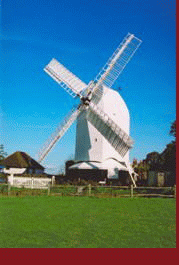




  |
 |
   |
 | ||
      |
   |
| www.oldlandwindmill.co.uk |
Diary Volume 4 November 2007 to October 2008 |
| Oldland Windmill is an 18th century post-mill situated in the village of Keymer in the County of West Sussex. She is currently being restored to full working order by a dedicated team of local volunteers. |
|
 |
| Regular visitors to this website will know that I only update the site two or three times a year. Should you wish, I can e-mail you when an update has been published. Please let me have your e-mail address if you would like this service. My e-mail address is |
Diary November 2007 to October 2008 |
|
Long time since I last updated the Diary, my apologies, have been getting my sailing yacht seaworthy after 25 years laid up which took more time, and money, than I had bargained for. |
|
November 2007
The bottom stone, Bed Stone, is fixed and the top stone, Runner Stone, revolves. Very fine adjustments are required as the stones, when grinding, are only about the thickness of a postcard apart. This is done by a hand wheel and then the set gap is maintained at varying speeds by the centrifugal governor. | 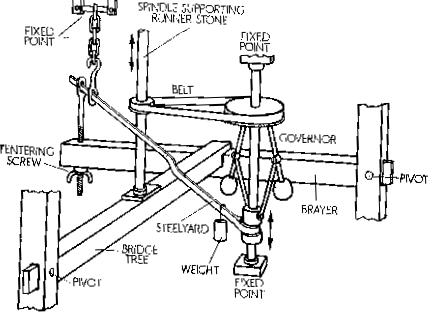 Tentering Gear |
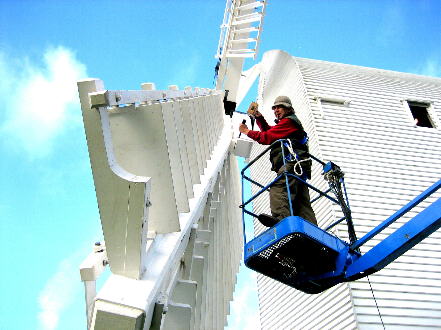 David cutting slot in stock to take U bolt clamp |
The first U clamp was fitted which holds the whip to the stock using Roger's cherry picker. |
|
Michael, Danny and Craig finished fitting the hornbeam teeth to the brakewheel. The brakewheel is fitted to the windshaft with wooden wedges and they started adjusting these to get the wheel to run true. First result was to get it running 1/8 inch out of circular and 1 inch of wobble on the flat plane at the rim. Further adjustments brought this down to the final running fit of 1/8 inch out of round and 1/8 inch out on the flat plane.  Wood wedges securing brakewheel onto windshaft |
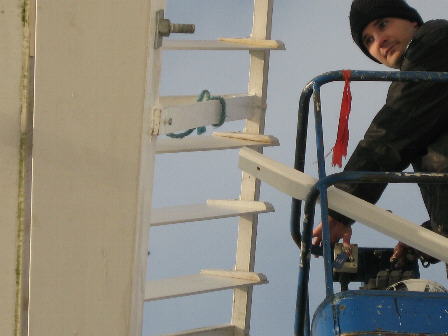 Philip fitting backstays |
All four U clamps now fitted to the whips. Now safe to rotate the sweeps by hand or in a light wind but we need to make and fit six back braces from the trailing edge of each sweep to the stock before we can run in strong winds. Each back brace has to be measured for length and angle from the cherry picker. |
|
December 2007
Roy was marking out the position and levels for a circular brick path for the bottom of the steps to rest on. The floor under the millstone had to be raised 2 inches at the front so that it is at right angles to the quant. A hole was then cut in the floor to let the millstone rest on its bearers. . |
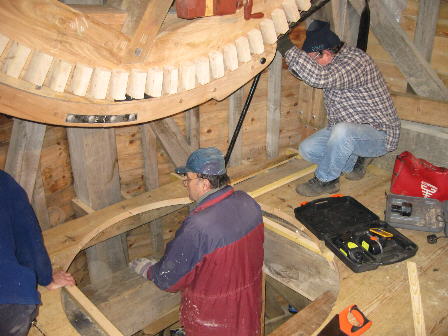 Hole cut in bin floor for bed stone
|
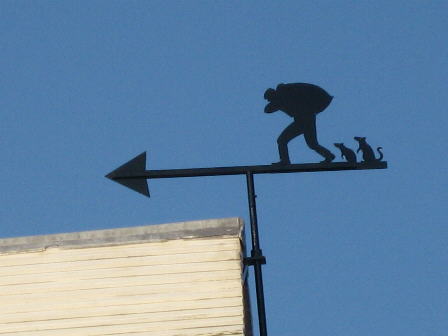 Michael's wind vane |
Michael made a lovely wind vane and this was fitted to the roof using the cherry picker. All off to Thatched Inn for a beer and lunch. |
|
January 2008
|
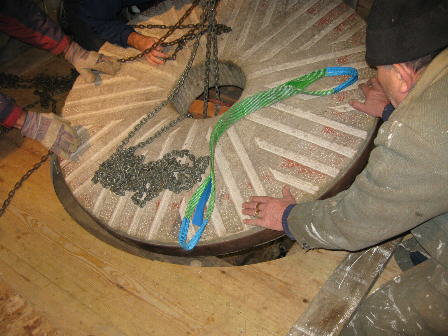 Bed stone being lowered into position |
February 2008 |
Last of the back braces fitted to the sweeps. 21ST FEBRUARY 2008 THE SWEEPS TURNED UNDER WIND POWER.
Everything worked well and the sweeps seem to be in balance, however the windshaft bearings area little tight and we will be able to tell the balance better when the bearings are run in. |
|
Started laying the brick path. |
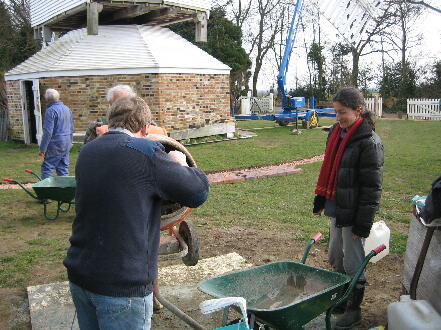 Laying the brick path 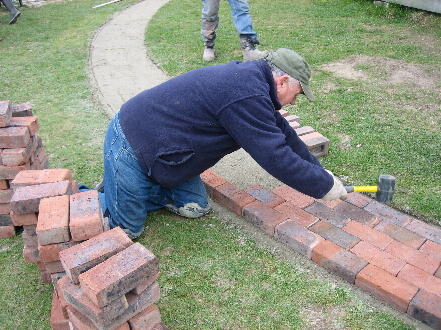 Roy laying the brick path |
|
March 2008
Site between brick path and round house levelled and turf re-laid. Bridge tree that supports the runner stone made and installed. |
|
April 2008
|
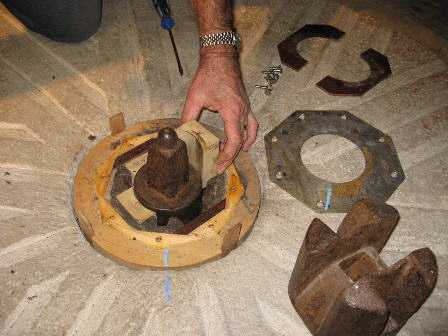 Holly bearing for shaft supporting the runner stone. Bottom right is the mace which sits on the shaft and is driven by the quant |
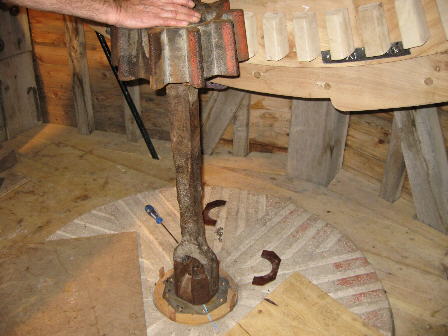 Quant in mesh with the mace |
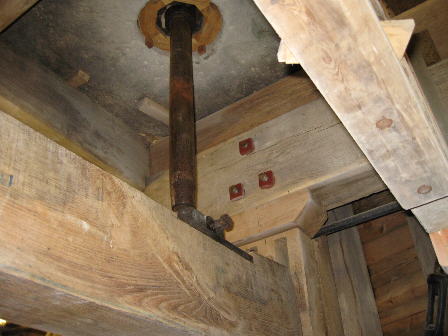 Shaft supporting runner stone on bridge tree |
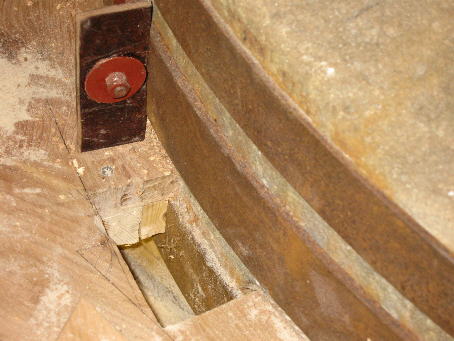 Leather scraper which rotates with the millstone and sweeps the flour down the hole into the spout |
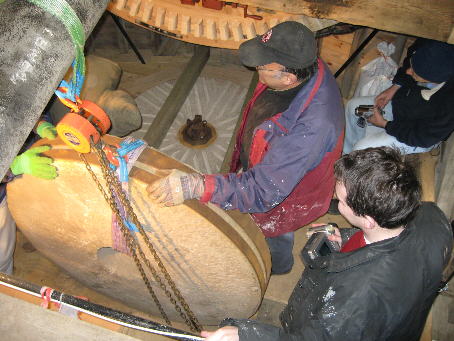 Runner stone being fitted above the bed stone |
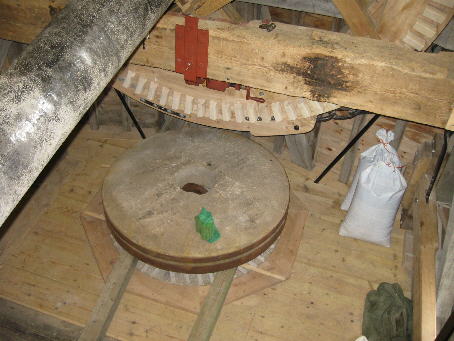 Runner stone in position |
|
The spout to take flour from stones to the spout floor under construction. Work started on the weather boarded skirt which bridges the gap between mill body and roundhouse roof. Michael Peat had constructed the wooden Tun, which encloses the millstones, at home and this was installed. Work was started on the design of the Bin floor. |
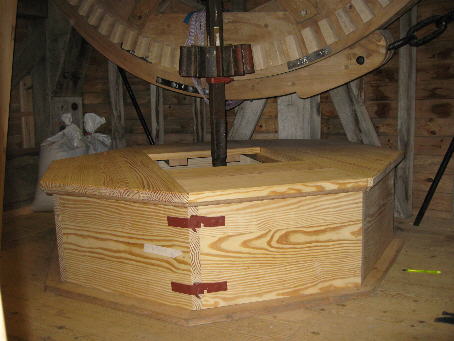 The tun, made by Michael, in position |
May 2008 |
The entrance to the bin floor was originally a ladder fixed to the rear wall of the mill in the sack hoist shaft but we decided to fit a hinged staircase, as well, for the use of visitors. |
|
The 4th May was an Open Day. The marquee and stalls were located in the field opposite the mill. Sunny and hot with a good turnout of visitors whose generosity was much appreciated. | |
|
The walls of the roundhouse were originally covered in black pitch to waterproof the solid brick wall. We had demolished the original walls, salvaged the bricks, spent many hours chipping the bricks clean and used them to rebuild the walls. Work continuing on the skirt. |
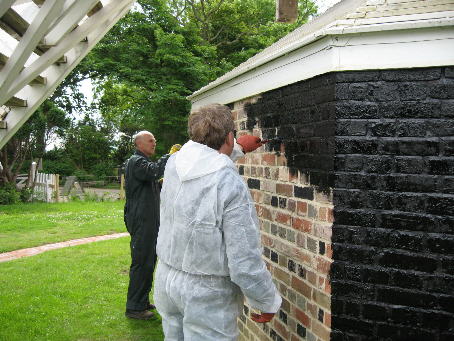 Vandals at work |
June 2008
|
Craig had made the Horse, part of the grain delivery system from bin floor to millstone eye, at home and it was installed on top of the Tun. |
|
Oak joists being fitted for the bin floor. Weather boarding being fitted to the skirt on the front of the mill. Oak skirt hangers fitted to the sides of the mill and shape of the bottom curve established. |
|
July 2008
Roundhouse roof cleaned, rubbed down and painted. |
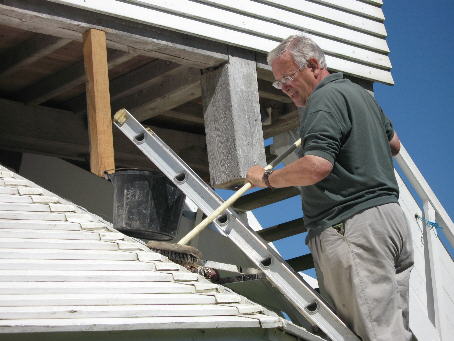 John cleaning the roundhouse roof |
|
Joists for rear of bin floor fitted and floorboards being laid. |
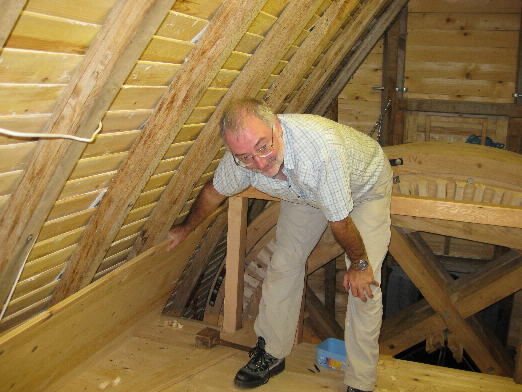 Craig fitting sides to grain bin 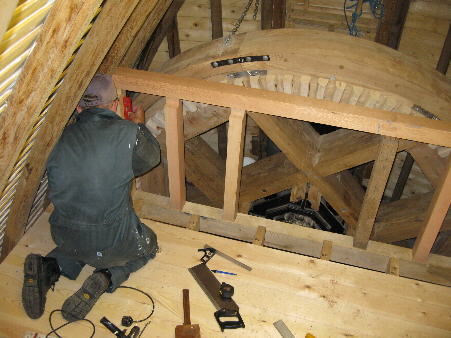 Bin floor under construction |
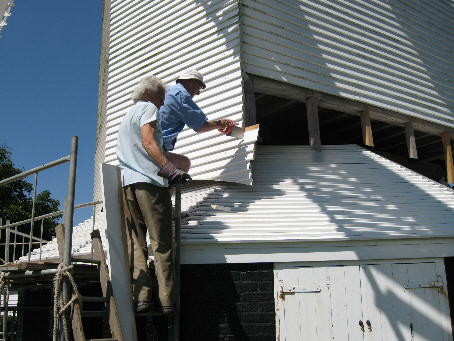 Fred and Peter trimming the skirt |
Weather boarding to skirt at the front of the mill completed. |
|
August 2008
The paintwork was in good condition with very little priming needing to be done. It was painted in May 2003 so it has done well. There was a debate as to whether to use scaffolding or a cherry picker to do the painting but it proved quite practical doing it from the cherry picker and saved a lot of money. The paint alone cost about £500 at £96 per 5 litre can. |
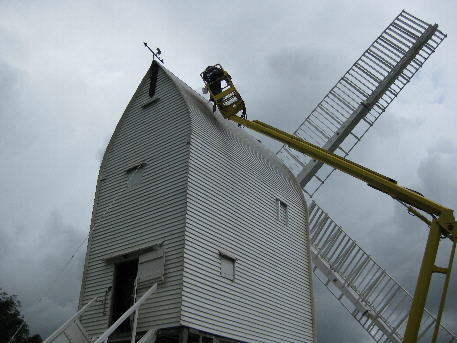 Using Plumpton College's cherry picker to paint the roof |
September 2008
|
We returned Plumpton College's cherry picker with many thanks and rushed to get the rest of the painting done by the Open Day on 21st September. We had a lot of bad weather and only got the job done on time by working extra days. |
|
The Flour Spout was made to take the flour from the millstones to the spout floor. Lots of work to get a super smooth varnished finish inside the spout so that the flour runs freely. |
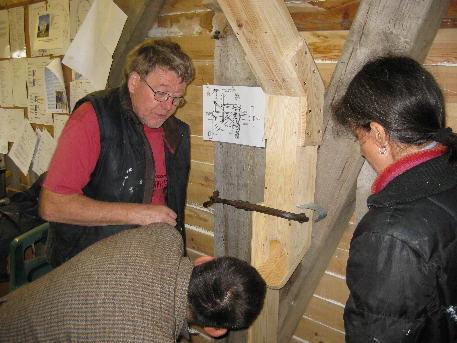 Keith with Ruth and her flour spout |
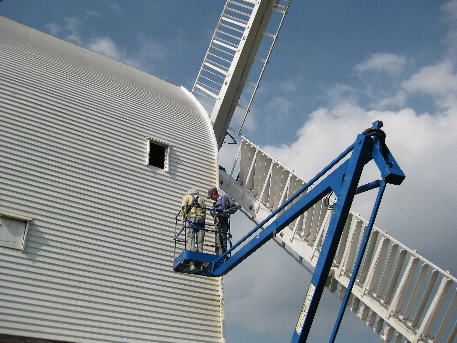 Using Roger's cherry picker to paint sides of mill. Skirt framing in position |
The framing to support the side skirt weatherboards ready but work delayed to enable the painting to be finished. |
|
The Sack Hoist drive from the brakewheel is located at the front of the bin floor so support framing being done at the same time as the bin floor. |
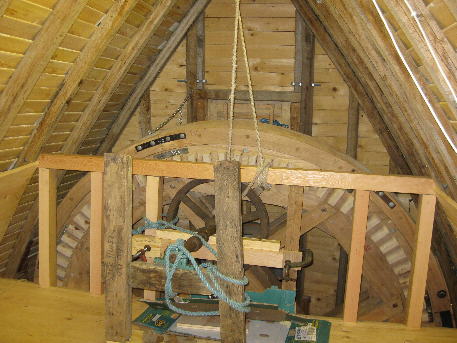 Sack hoist drive. New wooden teeth to be made on the edge of the iron wheel to engage with brakewheel teeth |
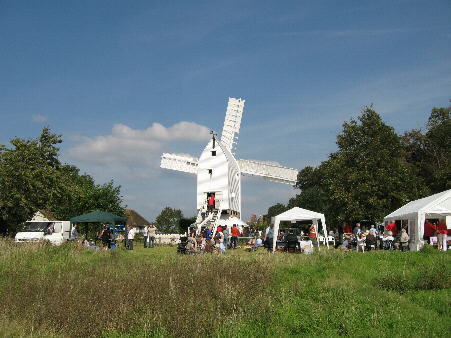 September Open Day |
21st September was an Open Day. |
|
October 2008
|
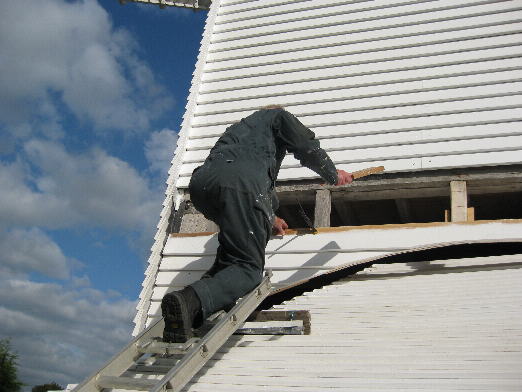 Fitting weather boarding to skirt |
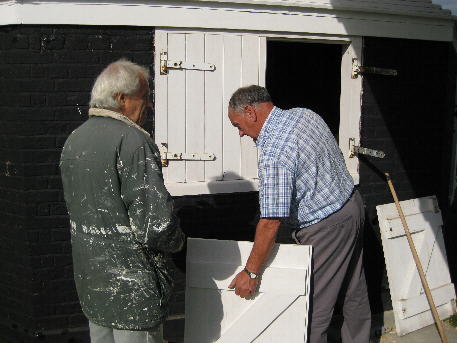 Roy fitting the new hatch 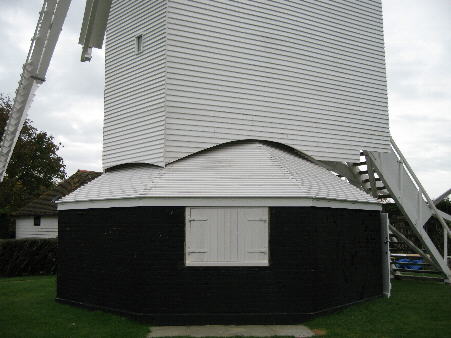 Skirt fitted |
When we rebuilt the roundhouse in 2004 we patched up the old side hatch as we wanted to use as much of the original mill as possible but now the hatch is showing too much rot to be repaired. Roy made and fitted a new hatch. |
|
THURSDAY 23rd OCTOBER 2008. NICE STRONG WIND FROM THE SW. WE DECIDED TO SEE IF WE CAN MAKE FLOUR. CAREFUL SETTING UP OF THE MILLSTONES BY DANNY, RUN THE SWEEPS WITHOUT MESHING IN THE QUANT TO SEE IF THE SWEEPS TURN WITH SUFFICIENT SPEED, LOOKS GOOD, PUT THE STONES INTO GEAR AND, HEY PRESTO, WE HAVE FLOUR. I TOOK SOME HOME AT LUNCHTIME , BAKED A FRUITCAKE FROM IT AND WE HAD IT FOR TEA THE SAME DAY WITH CHAMPAGNE AND SLOE GIN. We only made a bucket full of flour but it all ran smoothly. Work started on the mill restoration in 1980 but by 1990 it was decided that that the mill was in too bad a condition to restore and the only way forward was a complete rebuild. The mill was demolished and in 1995 the first of the new body frame was erected. So it has taken 13 years from that stage to make flour. As far as we can tell it is about 100 years since Oldland Windmill last ground. |
|
|
|
|
|
|
|
|
|
|
|
|
 |
 |
   Click here to visit Techpoint website |